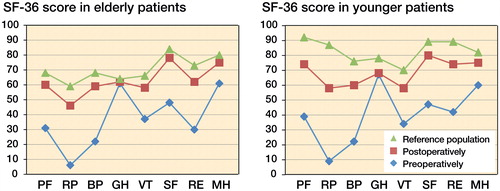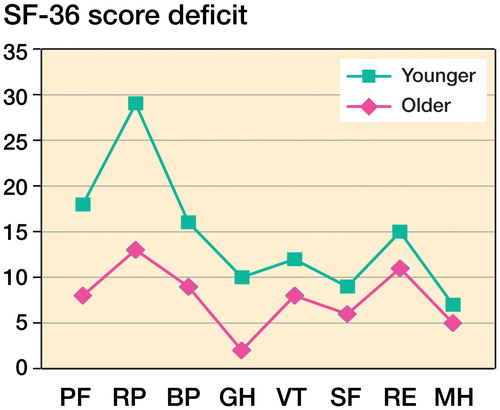Figures & data
Table 1. Dropout analysis comparing elderly and younger patients with complete and missing postoperative data in SweSpine regarding age, gender, level operated, VAS as an estimation of back and leg pain, SF-36 as an estimation of quality of life, and ODI as an estimation of disability. Elderly is defined as those aged ≥65 years, and younger refers to the sex-matched comparison group aged 20–64
Figure 1. Quality of life estimated by SF-36, pre- and postoperatively, in elderly and younger patients operated for LDH compared to a published age-matched reference data population* (Sullivan et al. Citation1994). Elderly is defi ned as those aged ≥65 years, and younger refers to the sex-matched comparison group aged 20–64. For Abbreviations, see .

Table 2. Preoperative and 1-year postoperative data regarding age, smoking, duration of back and leg pain, consumption of analgesics, and estimated walking distances. Elderly is defined as those aged ≥65 years, and younger refers to the sex-matched comparison group aged 20–64
Table 3. Preoperative and 1-year postoperative data regarding VAS as an estimation of back and leg pain, EuroQol and SF-36 as estimations of quality of life, and ODI as an estimation of disability. Data are mean (95% CI). Elderly is defined as those aged ≥65 years, and younger refers to the sex-matched comparison group aged 20–64
Figure 2. 1-year postoperative estimated point defi cit in quality of life estimated by SF-36, in elderly and younger patients operated for LDH compared to a published age-matched reference data population (Sullivan et al. Citation1994). Elderly is defi ned as patients aged ≥65 years of age, and younger refers to the sex-matched comparison group aged 20–64. For Abbreviations, see .

Table 4. Improvements from preoperatively to 1-year postoperatively in VAS as an estimation of back and leg pain, EuroQol and SF-36 as estimations of quality of life, and ODI as an estimation of disability. Data are mean (95% CI) or percentages. Elderly is defined as those aged ≥65 years, and younger refers to the sex-matched comparison group aged 20–64
